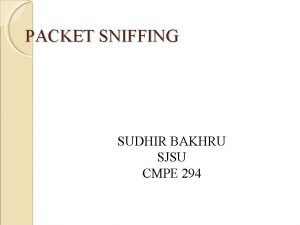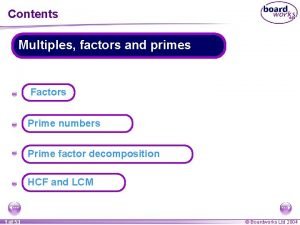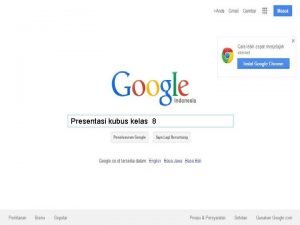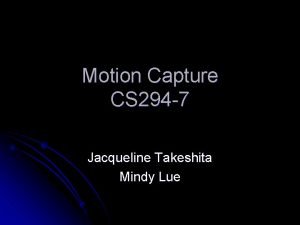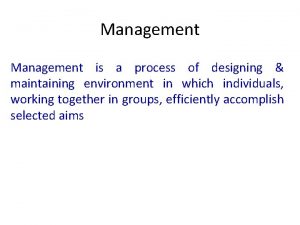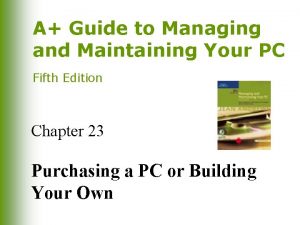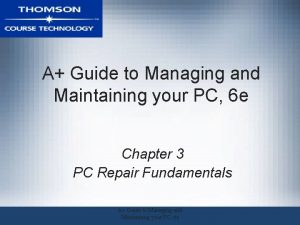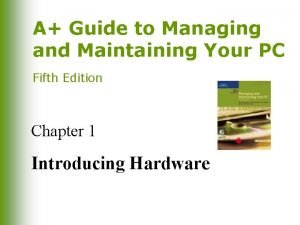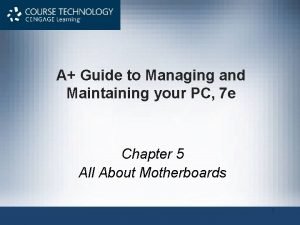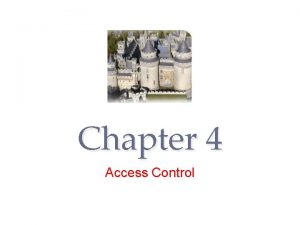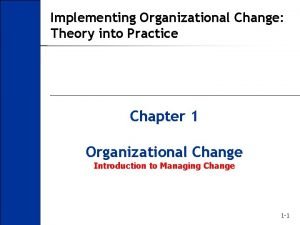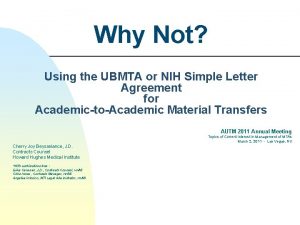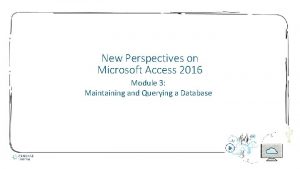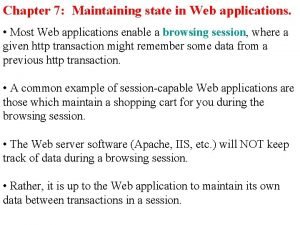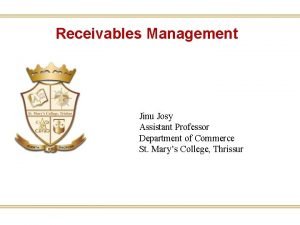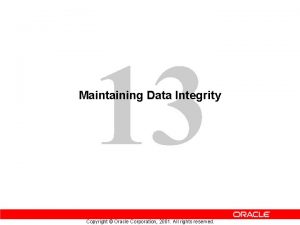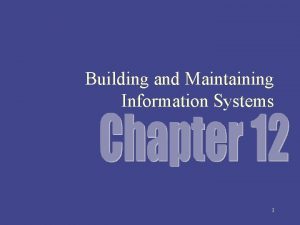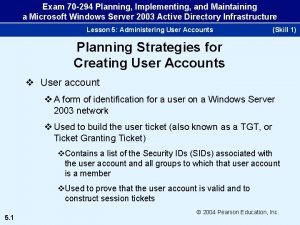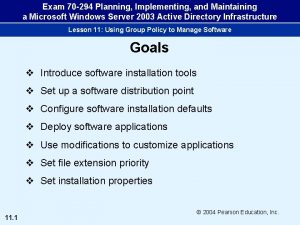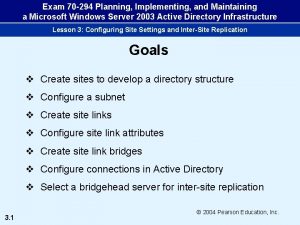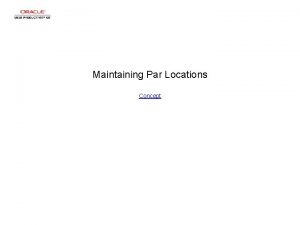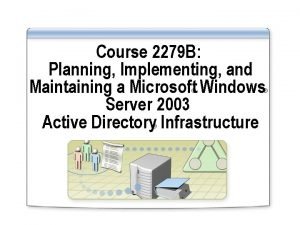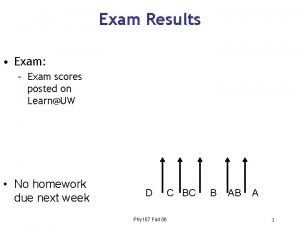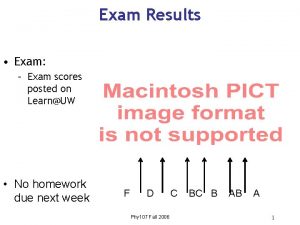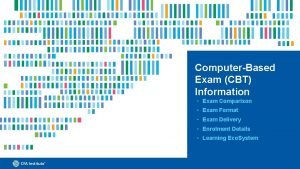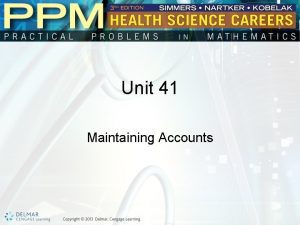Exam 70 294 Planning Implementing and Maintaining a


















































































- Slides: 82

Exam 70 -294 Planning, Implementing, and Maintaining a Microsoft Windows Server 2003 Active Directory Infrastructure Lesson 2: Implementing Active Directory Goals v Install Active Directory v Verify Active Directory installation v Introduce operations master roles v View the operations master role assignments for a domain v Transfer operations master roles v Implement an organizational unit structure within a domain v Examine application data partitions v Prepare for schema modifications 2. 1 © 2004 Pearson Education, Inc.

Exam 70 -294 Planning, Implementing, and Maintaining a Microsoft Windows Server 2003 Active Directory Infrastructure Lesson 2: Implementing Active Directory (Skill 1) Installing Active Directory v To organize objects and implement domain structure v Install Active Directory on a Windows Server 2003 computer using the Active Directory Installation Wizard v During first time installation v. Create the root domain, a new domain tree, and a new forest v. Designate a Windows Server 2003 computer as a domain controller 2. 2 © 2004 Pearson Education, Inc.

Exam 70 -294 Planning, Implementing, and Maintaining a Microsoft Windows Server 2003 Active Directory Infrastructure Lesson 2: Implementing Active Directory (Skill 1) Installing Active Directory (2) v Creating a domain v By default, the domain is configured to run in Windows 2000 mixed mode v Windows 2000 mixed mode allows various domain controllers to coexist v. Windows NT 4. 0 backup domain controllers (BDCs) v. Windows 2000 domain controllers (DCs) v. Windows Server 2003 domain controllers (DCs) 2. 3 © 2004 Pearson Education, Inc.

Exam 70 -294 Planning, Implementing, and Maintaining a Microsoft Windows Server 2003 Active Directory Infrastructure Lesson 2: Implementing Active Directory (Skill 1) Installing Active Directory (3) v If your network consists of only Windows 2000 and Windows Server 2003 domain controllers, switch to Windows 2000 native mode v Windows 2000 native mode supports only v. Windows 2000 domain controllers v. Windows Server 2003 domain controllers v Windows 2000 mixed mode and native mode are identical to those available in Windows 2000 2. 4 © 2004 Pearson Education, Inc.

Exam 70 -294 Planning, Implementing, and Maintaining a Microsoft Windows Server 2003 Active Directory Infrastructure Lesson 2: Implementing Active Directory (Skill 1) Installing Active Directory (4) v Windows Server 2003 provides two new modes v Windows Server 2003 mode v. Only supports Windows Server 2003 domain controllers v. Gives you the additional ability to rename domain controllers at any time v Windows Server 2003 interim mode is used when you upgrade a Windows NT 4. 0 primary domain controller (PDC) to Windows Server 2003 2. 5 © 2004 Pearson Education, Inc.

Exam 70 -294 Planning, Implementing, and Maintaining a Microsoft Windows Server 2003 Active Directory Infrastructure Lesson 2: Implementing Active Directory (Skill 1) Installing Active Directory (5) v During Active Directory installation, three components are installed v Domain Name System (DNS) service v Database and database log files v Shared system volume 2. 6 © 2004 Pearson Education, Inc.

Exam 70 -294 Planning, Implementing, and Maintaining a Microsoft Windows Server 2003 Active Directory Infrastructure Lesson 2: Implementing Active Directory (Skill 1) Figure 2 -1 Active Directory installation 2. 7 © 2004 Pearson Education, Inc.

Exam 70 -294 Planning, Implementing, and Maintaining a Microsoft Windows Server 2003 Active Directory Infrastructure Lesson 2: Implementing Active Directory (Skill 1) Figure 2 -2 Internet Protocol (TCP/IP) Properties dialog box 2. 8 © 2004 Pearson Education, Inc.

Exam 70 -294 Planning, Implementing, and Maintaining a Microsoft Windows Server 2003 Active Directory Infrastructure Lesson 2: Implementing Active Directory (Skill 1) Figure 2 -3 Running Dcpromo 2. 9 © 2004 Pearson Education, Inc.

Exam 70 -294 Planning, Implementing, and Maintaining a Microsoft Windows Server 2003 Active Directory Infrastructure Lesson 2: Implementing Active Directory (Skill 1) Figure 2 -4 Detecting network settings 2. 10 © 2004 Pearson Education, Inc.

Exam 70 -294 Planning, Implementing, and Maintaining a Microsoft Windows Server 2003 Active Directory Infrastructure Lesson 2: Implementing Active Directory (Skill 1) Figure 2 -5 The Server Role screen 2. 11 © 2004 Pearson Education, Inc.

Exam 70 -294 Planning, Implementing, and Maintaining a Microsoft Windows Server 2003 Active Directory Infrastructure Lesson 2: Implementing Active Directory (Skill 1) Figure 2 -6 The Operating System Compatibility screen 2. 12 © 2004 Pearson Education, Inc.

Exam 70 -294 Planning, Implementing, and Maintaining a Microsoft Windows Server 2003 Active Directory Infrastructure Lesson 2: Implementing Active Directory (Skill 1) Figure 2 -7 The Domain Controller Type screen 2. 13 © 2004 Pearson Education, Inc.

Exam 70 -294 Planning, Implementing, and Maintaining a Microsoft Windows Server 2003 Active Directory Infrastructure Lesson 2: Implementing Active Directory (Skill 1) Figure 2 -8 The Create New Domain screen 2. 14 © 2004 Pearson Education, Inc.

Exam 70 -294 Planning, Implementing, and Maintaining a Microsoft Windows Server 2003 Active Directory Infrastructure Lesson 2: Implementing Active Directory (Skill 1) Figure 2 -9 The Permissions screen 2. 15 © 2004 Pearson Education, Inc.

Exam 70 -294 Planning, Implementing, and Maintaining a Microsoft Windows Server 2003 Active Directory Infrastructure Lesson 2: Implementing Active Directory (Skill 1) Figure 2 -10 Adding a client to a domain 2. 16 © 2004 Pearson Education, Inc.

Exam 70 -294 Planning, Implementing, and Maintaining a Microsoft Windows Server 2003 Active Directory Infrastructure Lesson 2: Implementing Active Directory (Skill 2) Verifying Active Directory Installation v After you install Active Directory on the first domain controller, you may need to additional Active Directory domain controllers v Before installing additional domain controllers v You need installation-critical information from Active Directory v You must verify the initial installation to make sure certain components were successfully installed 2. 17 © 2004 Pearson Education, Inc.

Exam 70 -294 Planning, Implementing, and Maintaining a Microsoft Windows Server 2003 Active Directory Infrastructure Lesson 2: Implementing Active Directory (Skill 2) Verifying Active Directory Installation (2) v Use the Active Directory Users and Computers console to verify an Active Directory installation v Use this console, which is an administrative tool, to create and delete objects, set their permissions, and modify their properties v Use this console to control primary objects v. Organizational units (OUs) v. Windows Server 2003 user accounts, group accounts, computer accounts v. Published printers 2. 18 © 2004 Pearson Education, Inc.

Exam 70 -294 Planning, Implementing, and Maintaining a Microsoft Windows Server 2003 Active Directory Infrastructure Lesson 2: Implementing Active Directory (Skill 2) Verifying Active Directory Installation (3) v Verifying an Active Directory installation v Verify the presence of the domain that you specified during the Active Directory installation v Verify the presence of your new domain controller in the domain controllers OU v The presence of certain administrative tools also verifies that Active Directory was successfully installed v Active Directory and Trusts console v Active Directory Sites and Services console 2. 19 © 2004 Pearson Education, Inc.

Exam 70 -294 Planning, Implementing, and Maintaining a Microsoft Windows Server 2003 Active Directory Infrastructure Lesson 2: Implementing Active Directory (Skill 2) Verifying Active Directory Installation (4) v Use the Active Directory Domains and Trusts console v To manage the trust relationships between two or more domains in the same forest or different forests v To provide interoperability with other domains v To raise the domain functional level for a domain v To transfer the domain naming master role from one domain controller to another v To add or remove alternate User Principal Name (UPN) suffixes to/from user logon names 2. 20 © 2004 Pearson Education, Inc.

Exam 70 -294 Planning, Implementing, and Maintaining a Microsoft Windows Server 2003 Active Directory Infrastructure Lesson 2: Implementing Active Directory (Skill 2) Figure 2 -11 The Active Directory Domains and Trusts console 2. 21 © 2004 Pearson Education, Inc.

Exam 70 -294 Planning, Implementing, and Maintaining a Microsoft Windows Server 2003 Active Directory Infrastructure Lesson 2: Implementing Active Directory (Skill 2) Verifying Active Directory Installation (5) v Use the Active Directory Sites and Services console v To create sites and subnets v To move domain controllers to the correct sites v To configure servers as global catalog servers v To create site links v This information is used to decide the replication method for directory information and to process service requests 2. 22 © 2004 Pearson Education, Inc.

Exam 70 -294 Planning, Implementing, and Maintaining a Microsoft Windows Server 2003 Active Directory Infrastructure Lesson 2: Implementing Active Directory (Skill 2) Figure 2 -12 The Active Directory Sites and Services console 2. 23 © 2004 Pearson Education, Inc.

Exam 70 -294 Planning, Implementing, and Maintaining a Microsoft Windows Server 2003 Active Directory Infrastructure Lesson 2: Implementing Active Directory (Skill 2) Figure 2 -13 Verifying the presence of a domain controller 2. 24 © 2004 Pearson Education, Inc.

Exam 70 -294 Planning, Implementing, and Maintaining a Microsoft Windows Server 2003 Active Directory Infrastructure Lesson 2: Implementing Active Directory (Skill 2) Figure 2 -14 The Sysvol directory 2. 25 © 2004 Pearson Education, Inc.

Exam 70 -294 Planning, Implementing, and Maintaining a Microsoft Windows Server 2003 Active Directory Infrastructure Lesson 2: Implementing Active Directory (Skill 2) Figure 2 -15 The Ntds folder 2. 26 © 2004 Pearson Education, Inc.

Exam 70 -294 Planning, Implementing, and Maintaining a Microsoft Windows Server 2003 Active Directory Infrastructure Lesson 2: Implementing Active Directory (Skill 2) Verifying Active Directory Installation (6) v In addition to the three default consoles, you can also install an additional tool called the Active Directory Schema snap-in v Permits you to view and modify the schema v The schema defines the types of objects and the type of information pertaining to those objects that can be stored in Active Directory 2. 27 © 2004 Pearson Education, Inc.

Exam 70 -294 Planning, Implementing, and Maintaining a Microsoft Windows Server 2003 Active Directory Infrastructure Lesson 2: Implementing Active Directory (Skill 2) Figure 2 -16 The Active Directory Schema snap-in installed 2. 28 © 2004 Pearson Education, Inc.

Exam 70 -294 Planning, Implementing, and Maintaining a Microsoft Windows Server 2003 Active Directory Infrastructure Lesson 2: Implementing Active Directory (Skill 3) Introducing Operations Master Roles v Replication models v Multi-master replication model v. Used to control most functions v. All domain controllers have the ability to modify Active Directory v Single-master model v. Used when a single domain controller modifies data to control certain types of events in Active Directory 2. 29 © 2004 Pearson Education, Inc.

Exam 70 -294 Planning, Implementing, and Maintaining a Microsoft Windows Server 2003 Active Directory Infrastructure Lesson 2: Implementing Active Directory (Skill 3) Introducing Operations Master Roles (2) v Each of these special functions is controlled by FSMO (Flexible Single Masters of Operations) servers or, more typically, operations masters v Types of special functions v Forest-wide operations master roles v Domain-wide operations master roles 2. 30 © 2004 Pearson Education, Inc.

Exam 70 -294 Planning, Implementing, and Maintaining a Microsoft Windows Server 2003 Active Directory Infrastructure Lesson 2: Implementing Active Directory (Skill 3) Introducing Operations Master Roles (3) v Forest-wide operations master roles v Two forest-wide FSMO roles v. Schema master role v. Domain naming master role v Each of these roles can reside on only a single server for the entire forest v By default, both roles will be held by the first domain controller created in the root domain of the forest 2. 31 © 2004 Pearson Education, Inc.

Exam 70 -294 Planning, Implementing, and Maintaining a Microsoft Windows Server 2003 Active Directory Infrastructure Lesson 2: Implementing Active Directory (Skill 3) Introducing Operations Master Roles (4) v Domain-wide operations master roles v Three domain-wide roles v. Primary domain controller (PDC) emulator role v. Relative ID (RID) master role v. Infrastructure master role v Each of these roles can reside on only a single domain controller in each domain v By default, all three roles will be held by the first domain controller created in each domain 2. 32 © 2004 Pearson Education, Inc.

Exam 70 -294 Planning, Implementing, and Maintaining a Microsoft Windows Server 2003 Active Directory Infrastructure Lesson 2: Implementing Active Directory (Skill 3) Introducing Operations Master Roles (5) v When you create the first domain in a new forest, by default, all five operations master roles are assigned to the first domain controller in that domain v Active Directory assigns only the domain-wide operations master roles to the first domain controller of any subsequent child domains that you create in the forest v The first domain controller in each of the other domains holds the domain-wide operations master roles 2. 33 © 2004 Pearson Education, Inc.

Exam 70 -294 Planning, Implementing, and Maintaining a Microsoft Windows Server 2003 Active Directory Infrastructure Lesson 2: Implementing Active Directory (Skill 3) Introducing Operations Master Roles (6) v Guidelines for planning operations master roles for per -forest roles v Assign the two forest-wide roles to a high-uptime server; backups of this machine are of special importance v Assign the schema master and the domain naming master roles to a single domain controller in one of the domains in the forest 2. 34 © 2004 Pearson Education, Inc.

Exam 70 -294 Planning, Implementing, and Maintaining a Microsoft Windows Server 2003 Active Directory Infrastructure Lesson 2: Implementing Active Directory (Skill 3) Introducing Operations Master Roles (7) v Guidelines for planning operations master roles for perdomain roles v Have at least one additional domain controller act as a standby operations master for other operations masters v If a domain controller fails, the standby domain controller can be manually configured to seize the failed domain controller’s roles 2. 35 © 2004 Pearson Education, Inc.

Exam 70 -294 Planning, Implementing, and Maintaining a Microsoft Windows Server 2003 Active Directory Infrastructure Lesson 2: Implementing Active Directory (Skill 3) Introducing Operations Master Roles (8) v Guidelines for planning operations master roles for perdomain roles v Assign both the RID master and the PDC emulator roles to the same domain controller v If the domain is large, these roles can be assigned to separate domain controllers to reduce the load on the PDC emulator v Make sure these servers are always capable of communicating with each other 2. 36 © 2004 Pearson Education, Inc.

Exam 70 -294 Planning, Implementing, and Maintaining a Microsoft Windows Server 2003 Active Directory Infrastructure Lesson 2: Implementing Active Directory (Skill 3) Introducing Operations Master Roles (9) v Guidelines for planning operations master roles for perdomain roles v If there is more than one domain, do not assign the infrastructure master role to a domain controller that is hosting the global catalog service v Global catalog v. Stores information about objects in a tree or a forest v. When this information changes, the global catalog updates the information through replication and always contains the latest information about objects 2. 37 © 2004 Pearson Education, Inc.

Exam 70 -294 Planning, Implementing, and Maintaining a Microsoft Windows Server 2003 Active Directory Infrastructure Lesson 2: Implementing Active Directory (Skill 3) Introducing Operations Master Roles (10) v Guidelines for planning operations master roles for per-domain roles v If you assign the infrastructure master role to a domain controller that is also a global catalog server, the infrastructure master will not function properly, because there are no “phantom” references for it to update v If possible, try to place the domain naming master on a server hosting the global catalog 2. 38 © 2004 Pearson Education, Inc.

Exam 70 -294 Planning, Implementing, and Maintaining a Microsoft Windows Server 2003 Active Directory Infrastructure Lesson 2: Implementing Active Directory (Skill 4) Viewing the Operations Master Role Assignments for a Domain v To monitor the operations master roles, you must identify and view the domain controllers that hold the roles v Regular monitoring of the operations masters roles in a domain or forest v Enables you to determine the performance and load on each of the operations masters v This enables you to decide which roles must be transferred to other domain controllers 2. 39 © 2004 Pearson Education, Inc.

Exam 70 -294 Planning, Implementing, and Maintaining a Microsoft Windows Server 2003 Active Directory Infrastructure Lesson 2: Implementing Active Directory (Skill 4) Viewing the Operations Master Role Assignments for a Domain (2) v To view all of the domain-wide operations master role assignments, use the Active Directory Users and Computers console v To view the schema master and the domain naming master roles, use the Active Directory Schema snap -in and the Active Directory Domains and Trusts console 2. 40 © 2004 Pearson Education, Inc.

Exam 70 -294 Planning, Implementing, and Maintaining a Microsoft Windows Server 2003 Active Directory Infrastructure Lesson 2: Implementing Active Directory (Skill 4) Figure 2 -17 Viewing the default domain-wide operations master role assignments 2. 41 © 2004 Pearson Education, Inc.

Exam 70 -294 Planning, Implementing, and Maintaining a Microsoft Windows Server 2003 Active Directory Infrastructure Lesson 2: Implementing Active Directory (Skill 4) Figure 2 -18 The Change Schema Master dialog box 2. 42 © 2004 Pearson Education, Inc.

Exam 70 -294 Planning, Implementing, and Maintaining a Microsoft Windows Server 2003 Active Directory Infrastructure Lesson 2: Implementing Active Directory (Skill 4) Figure 2 -19 The Change Operations Master dialog box 2. 43 © 2004 Pearson Education, Inc.

Exam 70 -294 Planning, Implementing, and Maintaining a Microsoft Windows Server 2003 Active Directory Infrastructure Lesson 2: Implementing Active Directory (Skill 5) Transferring Operations Master Roles v After you have identified the domain controllers that hold the operations master roles, you can easily transfer roles between domain controllers v Conditions requiring that you transfer operations master roles v When you want to change the default operations master because the domain controller is unavailable for replication v When the performance of the domain controller holding the operations master role is deteriorating due to excess load 2. 44 © 2004 Pearson Education, Inc.

Exam 70 -294 Planning, Implementing, and Maintaining a Microsoft Windows Server 2003 Active Directory Infrastructure Lesson 2: Implementing Active Directory (Skill 5) Transferring Operations Master Roles (2) v You can transfer operations master roles between domain controllers within a forest, as well as within domains, with the assistance of the original operations master v To transfer an operations master role from one domain controller to another, make sure that both domain controllers are available and connected to each other through the network 2. 45 © 2004 Pearson Education, Inc.

Exam 70 -294 Planning, Implementing, and Maintaining a Microsoft Windows Server 2003 Active Directory Infrastructure Lesson 2: Implementing Active Directory (Skill 5) Transferring Operations Master Roles (3) v Transferring an operations master role is a two-stage process v Connect to the new domain controller that will hold the role v Transfer the role to the domain controller you have identified 2. 46 © 2004 Pearson Education, Inc.

Exam 70 -294 Planning, Implementing, and Maintaining a Microsoft Windows Server 2003 Active Directory Infrastructure Lesson 2: Implementing Active Directory (Skill 5) Transferring Operations Master Roles (4) v You use the Active Directory Users and Computers console to transfer the relative ID master, PDC emulator, and infrastructure master roles v You use the Active Directory Domains and Trusts console to transfer the domain naming master role 2. 47 © 2004 Pearson Education, Inc.

Exam 70 -294 Planning, Implementing, and Maintaining a Microsoft Windows Server 2003 Active Directory Infrastructure Lesson 2: Implementing Active Directory (Skill 5) Transferring Operations Master Roles (5) v Failure of an operations master v An operations master may be unavailable due to a system failure v If there is any chance of recovering it, you should do so v If you cannot recover it, you can force the transfer of the operations master role to another Windows Server 2003 domain controller without the cooperation of the existing owner of the roles v. This process is called seizing the role v. Use the Ntdsutil. exe utility at the command prompt to seize any operations master role 2. 48 © 2004 Pearson Education, Inc.

Exam 70 -294 Planning, Implementing, and Maintaining a Microsoft Windows Server 2003 Active Directory Infrastructure Lesson 2: Implementing Active Directory (Skill 6) Implementing an Organizational Unit Structure within a Domain v Planning and creating an organizational unit (OU) structure is the last activity you perform to complete the implementation of Active Directory v OUs are container objects used to organize objects in a domain into logical groups to centralize and simplify administration of a large number of objects v You can manage users easily and efficiently in an OU v In a multiple-domain model, each domain implements its own OU hierarchy 2. 49 © 2004 Pearson Education, Inc.

Exam 70 -294 Planning, Implementing, and Maintaining a Microsoft Windows Server 2003 Active Directory Infrastructure Lesson 2: Implementing Active Directory (Skill 6) Implementing an Organizational Unit Structure within a Domain (2) v Advantages of creating OUs v You can apply Group Policy to a particular group of users or computers independently of other groups of users and computers in other OUs v You can structure a domain v. According to the departments and locations in your organization v. Without OUs, all users are maintained in a single list under a domain 2. 50 © 2004 Pearson Education, Inc.

Exam 70 -294 Planning, Implementing, and Maintaining a Microsoft Windows Server 2003 Active Directory Infrastructure Lesson 2: Implementing Active Directory (Skill 6) Implementing an Organizational Unit Structure within a Domain (3) v Advantages of creating OUs v You can delegate administrative control over network resources to users v You can easily accommodate any changes that take place in the structure of your organization, for example, reorganizing users between OUs requires less time and effort than reorganizing users between domains 2. 51 © 2004 Pearson Education, Inc.

Exam 70 -294 Planning, Implementing, and Maintaining a Microsoft Windows Server 2003 Active Directory Infrastructure Lesson 2: Implementing Active Directory (Skill 6) Implementing an Organizational Unit Structure within a Domain (4) v Advantages of creating OUs v OUs simplify the viewing and administration of directory objects within a domain v OUs allow administrators to have easy access to all objects at any level of the hierarchy v Plan your OU structure carefully so the organizational units represent your organization in a meaningful and manageable way 2. 52 © 2004 Pearson Education, Inc.

Exam 70 -294 Planning, Implementing, and Maintaining a Microsoft Windows Server 2003 Active Directory Infrastructure Lesson 2: Implementing Active Directory (Skill 6) Implementing an Organizational Unit Structure within a Domain (5) v Three standard models are typically used to design an OU hierarchy v Business function-based v Geographically-based v A combination of both business function and geographically-based 2. 53 © 2004 Pearson Education, Inc.

Exam 70 -294 Planning, Implementing, and Maintaining a Microsoft Windows Server 2003 Active Directory Infrastructure Lesson 2: Implementing Active Directory (Skill 6) Implementing an Organizational Unit Structure within a Domain (6) v Use the business function-based model to create an OU structure that reflects the various business functions within an organization v Use the geographically-based model to create an OU structure that represents the location of branches in an organization 2. 54 © 2004 Pearson Education, Inc.

Exam 70 -294 Planning, Implementing, and Maintaining a Microsoft Windows Server 2003 Active Directory Infrastructure Lesson 2: Implementing Active Directory (Skill 6) Figure 2 -20 A business function-based OU structure 2. 55 © 2004 Pearson Education, Inc.

Exam 70 -294 Planning, Implementing, and Maintaining a Microsoft Windows Server 2003 Active Directory Infrastructure Lesson 2: Implementing Active Directory (Skill 6) Figure 2 -21 A geographically-based OU structure 2. 56 © 2004 Pearson Education, Inc.

Exam 70 -294 Planning, Implementing, and Maintaining a Microsoft Windows Server 2003 Active Directory Infrastructure Lesson 2: Implementing Active Directory (Skill 6) Implementing an Organizational Unit Structure within a Domain (7) v Use a combination of business function and geographically-based models to create an OU structure that reflects the various business functions within the different branches of an organization 2. 57 © 2004 Pearson Education, Inc.

Exam 70 -294 Planning, Implementing, and Maintaining a Microsoft Windows Server 2003 Active Directory Infrastructure Lesson 2: Implementing Active Directory (Skill 6) Figure 2 -22 A business function and geographically-based OU structure 2. 58 © 2004 Pearson Education, Inc.

Exam 70 -294 Planning, Implementing, and Maintaining a Microsoft Windows Server 2003 Active Directory Infrastructure Lesson 2: Implementing Active Directory (Skill 6) Figure 2 -23 Creating an organizational unit 2. 59 © 2004 Pearson Education, Inc.

Exam 70 -294 Planning, Implementing, and Maintaining a Microsoft Windows Server 2003 Active Directory Infrastructure Lesson 2: Implementing Active Directory (Skill 6) Implementing an Organizational Unit Structure within a Domain (8) v Each OU you create contains a set of default properties v Each OU also has additional properties v Properties are attributes you use to locate the OU v Use the Active Directory Users and Computers console to set the properties 2. 60 © 2004 Pearson Education, Inc.

Exam 70 -294 Planning, Implementing, and Maintaining a Microsoft Windows Server 2003 Active Directory Infrastructure Lesson 2: Implementing Active Directory (Skill 6) Figure 2 -24 MKTG Properties dialog box 2. 61 © 2004 Pearson Education, Inc.

Exam 70 -294 Planning, Implementing, and Maintaining a Microsoft Windows Server 2003 Active Directory Infrastructure Lesson 2: Implementing Active Directory (Skill 7) Understanding Application Data Partitions v Application data partitions v Are special database structures within Active Directory v They hold information specific to a particular application v To fully understand why they are necessary, you must first understand how they function in Active Directory 2. 62 © 2004 Pearson Education, Inc.

Exam 70 -294 Planning, Implementing, and Maintaining a Microsoft Windows Server 2003 Active Directory Infrastructure Lesson 2: Implementing Active Directory (Skill 7) Understanding Application Data Partitions (2) v A partition in Active Directory is a section of the database v With its own root name (using LDAP distinguished names) v With its own replication topology v. The critical principle is replication topology v. Since all partitions have their own topology, information changes in one partition do not force replication to other partitions 2. 63 © 2004 Pearson Education, Inc.

Exam 70 -294 Planning, Implementing, and Maintaining a Microsoft Windows Server 2003 Active Directory Infrastructure Lesson 2: Implementing Active Directory (Skill 7) Figure 2 -25 Using application data partitions 2. 64 © 2004 Pearson Education, Inc.

Exam 70 -294 Planning, Implementing, and Maintaining a Microsoft Windows Server 2003 Active Directory Infrastructure Lesson 2: Implementing Active Directory (Skill 7) Understanding Application Data Partitions (3) v Application data partitions have their own naming convention v Applies to DNS names and LDAP distinguished names v From the DNS side, an application data partition is typically configured as a child domain of an Active Directory domain v From the LDAP side, the partition has its own LDAP distinguished name 2. 65 © 2004 Pearson Education, Inc.

Exam 70 -294 Planning, Implementing, and Maintaining a Microsoft Windows Server 2003 Active Directory Infrastructure Lesson 2: Implementing Active Directory (Skill 7) Understanding Application Data Partitions (4) v LDAP distinguished name v An LDAP naming convention that is used in most, if not all, LDAP compliant databases v Think of it as a path name describing the entire path to the object from within the database v LDAP names are particularly important because some of the advanced Active Directory utilities (such as Ntdsutil) require them 2. 66 © 2004 Pearson Education, Inc.

Exam 70 -294 Planning, Implementing, and Maintaining a Microsoft Windows Server 2003 Active Directory Infrastructure Lesson 2: Implementing Active Directory (Skill 7) Understanding Application Data Partitions (5) v Administering application data partitions v Typically, you will not need to perform any real administration v Your application will usually create the partition for you, and perform all writes and changes v Common current applications that make use of application data partitions are DNS and TAPI v In certain cases, you may be required to create an application data partition 2. 67 © 2004 Pearson Education, Inc.

Exam 70 -294 Planning, Implementing, and Maintaining a Microsoft Windows Server 2003 Active Directory Infrastructure Lesson 2: Implementing Active Directory (Skill 7) Understanding Application Data Partitions (6) v To create an application data partition, you can use Ntdsutil. exe, a raw LDAP editor, or Active Directory Services Interface (ADSI) v Ntdsutil is the most accessible of these tools v It is a powerful and versatile tool for making major modifications to the Active Directory database v Since it is a very powerful application, you have the potential for making major mistakes very quickly 2. 68 © 2004 Pearson Education, Inc.

Exam 70 -294 Planning, Implementing, and Maintaining a Microsoft Windows Server 2003 Active Directory Infrastructure Lesson 2: Implementing Active Directory (Skill 7) Understanding Application Data Partitions (7) v Ntdsutil command line utility v Must be run in Directory Services Restore Mode on the domain controller on which you wish to make a change v Application data partitions can only be created by Enterprise Administrators v By default, the only Enterprise Administrator is the Administrator account in the forest root domain 2. 69 © 2004 Pearson Education, Inc.

Exam 70 -294 Planning, Implementing, and Maintaining a Microsoft Windows Server 2003 Active Directory Infrastructure Lesson 2: Implementing Active Directory (Skill 8) Preparing for Schema Modifications v Schema v Considered the blueprint or rulebook for Active Directory v Defines the structure and rules for the Active Directory database v To understand more specifically what the schema does, you need to understand more about the structure of Active Directory 2. 70 © 2004 Pearson Education, Inc.

Exam 70 -294 Planning, Implementing, and Maintaining a Microsoft Windows Server 2003 Active Directory Infrastructure Lesson 2: Implementing Active Directory (Skill 8) Preparing for Schema Modifications (2) v Active Directory is composed of various types of objects v Each object is defined by its type, which is referred to as the object class v Each object class is defined by the attributes included in the class v Attributes are specific fields for the object that store a particular type of information v Different object classes can have different attributes, which are suited to the needs of the object 2. 71 © 2004 Pearson Education, Inc.

Exam 70 -294 Planning, Implementing, and Maintaining a Microsoft Windows Server 2003 Active Directory Infrastructure Lesson 2: Implementing Active Directory (Skill 8) Figure 2 -26 Object classes and attributes 2. 72 © 2004 Pearson Education, Inc.

Exam 70 -294 Planning, Implementing, and Maintaining a Microsoft Windows Server 2003 Active Directory Infrastructure Lesson 2: Implementing Active Directory (Skill 8) Preparing for Schema Modifications (3) v You can examine and change most of the attributes for an object class by opening the object class in the Active Directory Schema snap-in v You can add attributes to an existing class v You can create a new class using new or existing attributes to drastically change the functionality of Active Directory v This allows Active Directory to support your own customized applications and data 2. 73 © 2004 Pearson Education, Inc.

Exam 70 -294 Planning, Implementing, and Maintaining a Microsoft Windows Server 2003 Active Directory Infrastructure Lesson 2: Implementing Active Directory (Skill 8) Preparing for Schema Modifications (4) v A mistake made in the schema can have very severe consequences v Microsoft has put several safeguards in place to reduce the chance that mistakes may occur when you are viewing or editing the schema 2. 74 © 2004 Pearson Education, Inc.

Exam 70 -294 Planning, Implementing, and Maintaining a Microsoft Windows Server 2003 Active Directory Infrastructure Lesson 2: Implementing Active Directory (Skill 8) Preparing for Schema Modifications (5) v Some of Microsoft’s safeguards v Object classes and attributes can be deactivated, but they cannot be deleted v. Deactivating a class results in the inability to create new objects in that class. v. Deactivating an attribute results in the inability to add the attribute to other classes v Mandatory attributes of an existing class cannot be deactivated 2. 75 © 2004 Pearson Education, Inc.

Exam 70 -294 Planning, Implementing, and Maintaining a Microsoft Windows Server 2003 Active Directory Infrastructure Lesson 2: Implementing Active Directory (Skill 8) Preparing for Schema Modifications (6) v Some of Microsoft’s safeguards v Default attributes, which are required for Active Directory to function properly, cannot be deactivated v The schema can only be modified on the schema master v Only members of the Schema Admins group have permission to modify the schema, by default v The Active Directory Schema snap-in is not installed by default 2. 76 © 2004 Pearson Education, Inc.

Exam 70 -294 Planning, Implementing, and Maintaining a Microsoft Windows Server 2003 Active Directory Infrastructure Lesson 2: Implementing Active Directory (Skill 8) Preparing for Schema Modifications (7) v Precautions exist because of the scope of schema modifications v However, there a few instances in which a schema modification is warranted 2. 77 © 2004 Pearson Education, Inc.

Exam 70 -294 Planning, Implementing, and Maintaining a Microsoft Windows Server 2003 Active Directory Infrastructure Lesson 2: Implementing Active Directory (Skill 8) Preparing for Schema Modifications (8) v Most commonly, schema modifications are performed for one of two reasons v To support business requirements, you may need to add a new attribute or class to the schema v To support new Active Directory-integrated applications that store a portion of their data in the Active Directory database, you may need to supply new attributes or classes 2. 78 © 2004 Pearson Education, Inc.

Exam 70 -294 Planning, Implementing, and Maintaining a Microsoft Windows Server 2003 Active Directory Infrastructure Lesson 2: Implementing Active Directory (Skill 8) Preparing for Schema Modifications (9) v If you choose to modify the schema in the Active Directory Schema snap-in, follow these precautions v Thoroughly evaluate the need for the schema modification and make sure that modifying the schema is the best solution v Specifically define the modification to be performed v Create a script or use another programmatic method to apply the modification and test it thoroughly in an offline environment 2. 79 © 2004 Pearson Education, Inc.

Exam 70 -294 Planning, Implementing, and Maintaining a Microsoft Windows Server 2003 Active Directory Infrastructure Lesson 2: Implementing Active Directory (Skill 8) Preparing for Schema Modifications (10) v Steps to modify the schema v Connect to the schema operations master, preferably using an account that is not a member of the Schema Admins group v Use the Run as facility to launch the application you are using to modify the schema as a member of the Schema Admins group 2. 80 © 2004 Pearson Education, Inc.

Exam 70 -294 Planning, Implementing, and Maintaining a Microsoft Windows Server 2003 Active Directory Infrastructure Lesson 2: Implementing Active Directory (Skill 8) Preparing for Schema Modifications (11) v Steps to modify the schema v If the operations master is a Windows 2000 domain controller, enable writes on the schema v Modify the schema v If the operations master is a Windows 2000 domain controller, disable writes on the schema v Disconnect from the schema operations master 2. 81 © 2004 Pearson Education, Inc.

Exam 70 -294 Planning, Implementing, and Maintaining a Microsoft Windows Server 2003 Active Directory Infrastructure Lesson 2: Implementing Active Directory (Skill 8) Figure 2 -27 Viewing an object class in the Schema console 2. 82 © 2004 Pearson Education, Inc.
 Crm project design and planning process
Crm project design and planning process Pages 294 and 295
Pages 294 and 295 Art 294 a 311 cpc
Art 294 a 311 cpc Cmpe 294
Cmpe 294 Aaa 294
Aaa 294 Prime factors of 99
Prime factors of 99 Konversikan bilangan desimal 294 menjadi bilangan biner
Konversikan bilangan desimal 294 menjadi bilangan biner In 1971 there were 294 105 females
In 1971 there were 294 105 females Presentasi tentang kubus
Presentasi tentang kubus Mindylue
Mindylue Management issues central to strategy implementation
Management issues central to strategy implementation Mis issues in strategy implementation
Mis issues in strategy implementation Chapter 7 strategic management
Chapter 7 strategic management Tripod of pricing
Tripod of pricing Toyota brand hierarchy
Toyota brand hierarchy Designing and implementing brand architecture strategies
Designing and implementing brand architecture strategies Matching structure with strategy
Matching structure with strategy Low end entry level brand
Low end entry level brand Implementing strategies management and operations issues
Implementing strategies management and operations issues Role of nurse in maintenance of records and reports
Role of nurse in maintenance of records and reports The process of designing and maintaining an environment
The process of designing and maintaining an environment Building and maintaining a website
Building and maintaining a website Cleaning job sheet on kitchen premises
Cleaning job sheet on kitchen premises Retail image management
Retail image management Components of a retail image
Components of a retail image Chapter 17 maintaining your vehicle answers
Chapter 17 maintaining your vehicle answers Maintaining a healthy body composition and body image
Maintaining a healthy body composition and body image Vision focuses on the current reality and maintaining it
Vision focuses on the current reality and maintaining it Purchasing and maintaining a computer
Purchasing and maintaining a computer The process of designing and maintaining an environment
The process of designing and maintaining an environment Maintaining a healthy body composition and body image
Maintaining a healthy body composition and body image Building and maintaining customer relationships
Building and maintaining customer relationships The way you see your body is your
The way you see your body is your Maintaining a healthy body composition and body image
Maintaining a healthy body composition and body image Guide to managing and maintaining your pc
Guide to managing and maintaining your pc Guide to managing and maintaining your pc
Guide to managing and maintaining your pc Guide to managing and maintaining your pc
Guide to managing and maintaining your pc Implementing hrd programs
Implementing hrd programs Retail management notes doc
Retail management notes doc Product principle in portfolio assessment
Product principle in portfolio assessment Group dynamics examples
Group dynamics examples Challenges of implementing predictive analytics
Challenges of implementing predictive analytics Bert spector
Bert spector Implementing strategies marketing finance/accounting
Implementing strategies marketing finance/accounting Is the traditional method of implementing access control
Is the traditional method of implementing access control Checklist model for project selection
Checklist model for project selection Nfpa 1600 standard
Nfpa 1600 standard Implementing organizational change theory into practice
Implementing organizational change theory into practice Ubmta signatories
Ubmta signatories Nfpa 1600 business continuity programs
Nfpa 1600 business continuity programs Stateful firewall
Stateful firewall Examplanning. com
Examplanning. com Proactive planning and reactive planning
Proactive planning and reactive planning Long medium and short term planning in primary schools
Long medium and short term planning in primary schools What is language planning
What is language planning How to maintain deliverance by olukoya
How to maintain deliverance by olukoya Maintaining a professional image
Maintaining a professional image Class maintaining prefix
Class maintaining prefix Chapter 15:5 sterilizing with an autoclave
Chapter 15:5 sterilizing with an autoclave Chapter 11 managing weight and eating behaviors
Chapter 11 managing weight and eating behaviors Potential tension between maintaining confidentiality
Potential tension between maintaining confidentiality Characteristics of a teachable spirit
Characteristics of a teachable spirit Maintaining a website
Maintaining a website Access module 3 maintaining a database
Access module 3 maintaining a database Interpersonal accord and conformity
Interpersonal accord and conformity Maintaining effective partnerships
Maintaining effective partnerships Maintaining state in web applications
Maintaining state in web applications Maintaining transmission based isolation precautions
Maintaining transmission based isolation precautions Maintaining ecological balance
Maintaining ecological balance Cost of maintaining receivables
Cost of maintaining receivables Homeostasis blood calcium level
Homeostasis blood calcium level Maintaining student privacy
Maintaining student privacy Maintaining
Maintaining Maintaining curiosity
Maintaining curiosity Maintaining information systems
Maintaining information systems Strategic planning vs tactical planning
Strategic planning vs tactical planning Planning balance sheet in urban planning
Planning balance sheet in urban planning Scenario planning workforce planning
Scenario planning workforce planning Aggregate planning is capacity planning for:
Aggregate planning is capacity planning for: Aggregate planning is capacity planning for
Aggregate planning is capacity planning for Aggregate planning is capacity planning for
Aggregate planning is capacity planning for Benjamin zephaniah dyslexia
Benjamin zephaniah dyslexia World history final exam study guide
World history final exam study guide



